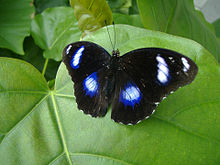
Trichogramma is a genus of minute polyphagous wasps that are endoparasitoids of insect eggs. Trichogramma is one of around 80 genera from the family Trichogrammatidae, with over 200 species worldwide.

Hypolimnas is a genus of tropical brush-footed butterflies commonly known as eggflies or diadems. The genus contains approximately 23 species, most of which are found in Africa, Asia, and Oceania. One species, the Danaid eggfly, is noted for its exceptionally wide distribution across five continents; it is the only Hypolimnas species found in the Americas.
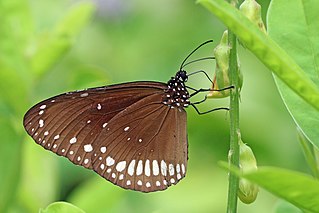
Euploea core, also known as the common crow, is a common butterfly found in South Asia to Australia. In India it is also sometimes referred to as the common Indian crow, and in Australia as the Australian crow. It belongs to the crows and tigers subfamily Danainae.

Tirumala limniace, the blue tiger, is a species of butterfly found in South Asia, and Southeast Asia that belongs to the brush-footed butterfly family, Nymphalidae. More specifically it is part of the crows and tigers or danaid group. This butterfly shows gregarious migratory behaviour in southern India. In some places, it may be found in congregations with Danaus genutia, Tirumala septentrionis, Euploea sylvester, Euploea core, Parantica aglea, and at high elevations, with Parantica nilgiriensis, on Crotalaria.

Eurema hecabe, the common grass yellow, is a small pierid butterfly species found in Asia, Africa and Australia. They are found flying close to the ground and are found in open grass and scrub habitats. It is simply known as "the grass yellow" in parts of its range; the general term otherwise refers to the entire genus Eurema.

Euploea sylvester, the double-branded crow, also known as the two-brand crow in Australia, is a butterfly found in South Asia, Southeast Asia and parts of Australia that belongs to the crows and tigers, that is, the danaid group of the brush-footed butterflies family.

Hypolimnas misippus, the Danaid eggfly, mimic, or diadem, is a widespread species of nymphalid butterfly. It is well known for polymorphism and mimicry. Males are blackish with distinctive white spots that are fringed in blue. Females are in multiple forms that include male-like forms while others closely resemble the toxic butterflies Danaus chrysippus and Danaus plexippus.
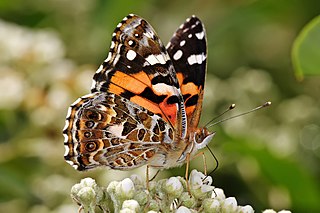
The Australian painted lady is a species of butterfly mostly confined to Australia, although westerly winds have dispersed it to islands east of Australia, including New Zealand. Debate surrounds the taxonomy of this species. Some believe that the Australian painted lady should be a subspecies of the painted lady due to the similarity in lifestyle and behaviour. Furthermore, the painted lady is found around the globe, but Australia is the only location in which it varies enough to be considered a separate species.
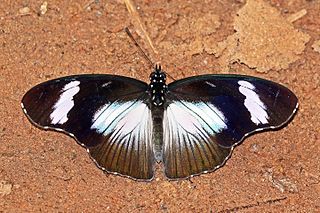
Hypolimnas anthedon, the variable eggfly or variable diadem, is a species of Hypolimnas butterfly found in southern Africa. There are four known subspecies, but it is very variable species with many morphs.

Hypolimnas deceptor, the deceptive eggfly or deceptive diadem, is a species of Hypolimnas butterfly found in southern Africa.
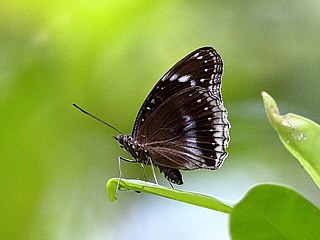
Hypolimnas alimena, the blue-banded eggfly, is a species of butterfly in the family Nymphalidae. It is found in the Solomon Islands, Indonesia, New Guinea and Australia.
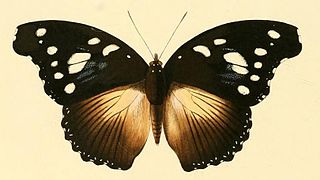
Hypolimnas dinarcha, the large variable diadem or large variable eggfly, is a butterfly in the family Nymphalidae. It is found in Sierra Leone, Liberia, Ivory Coast, Ghana, Nigeria, Cameroon, Gabon, the Republic of the Congo, Angola, the Democratic Republic of the Congo, the Central African Republic, Uganda, Kenya and Tanzania. The habitat consists of heavy lowland forests and secondary forests with a closed canopy.

Hypolimnas antilope, the spotted crow eggfly, is a butterfly of the family Nymphalidae. It is found from Malaya to the Philippines, New Guinea and Australia.
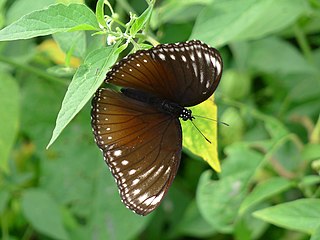
Hypolimnas anomala, commonly known as the Malayan eggfly or crow eggfly, is a species of eggfly.

Tirumala hamata, the dark tiger, is a butterfly of the family Nymphalidae. It is distributed from the Philippines to Australia and Pacific oceanic islands such as Samoa. In Australia, the butterflies perform mass migrations to the south in some years. In April 1995, the butterfly made a rare migratory journey to New Zealand, coinciding with the appearance of Hypolimnas bolina on the islands.

Hypolimnas octocula, the eight-spot butterfly, is a species of eggfly or diadem endemic to several islands and island chains in Oceania, including New Caledonia, Vanuatu and the Mariana Islands.
